Can You Compost Bones
Yes, you can compost bones, but you'll need specialized techniques and patience. Start by preparing the bones through soaking in vinegar, charring to remove grease, and grinding them into smaller pieces. The process works best with hot composting methods, maintaining temperatures between 130-160°F, and proper layering with nitrogen-rich materials. While bones decompose slowly, they'll enrich your soil with essential minerals like calcium and phosphorus. You'll want to manage potential challenges like odors and pests by burying the bones deep in your pile and maintaining ideal moisture levels. The thorough process yields remarkable benefits for your garden's long-term health.
This post may contain affiliate links. If you make a purchase through these links, I may earn a commission at no additional cost to you. Additionally, portions of this post may be generated using artificial intelligence (AI) technology. While we strive for accuracy, please be aware that AI-generated content may not always be perfect and should be fact-checked when necessary.
The Spatula Scoops
- Yes, bones can be composted but require preprocessing like boiling, grinding, or charring to break them down effectively.
- Hot composting methods with temperatures between 130-160°F work best for decomposing bones and releasing their nutrients.
- Bones provide essential minerals like calcium and phosphorus to soil, acting as a slow-release fertilizer for multiple growing seasons.
- Small bones from poultry or fish decompose faster than large mammal bones, which can take months to years to break down.
- Proper bone composting requires balanced carbon-to-nitrogen ratios, regular aeration, and measures to control odors and prevent pests.
Understanding Bone Composition
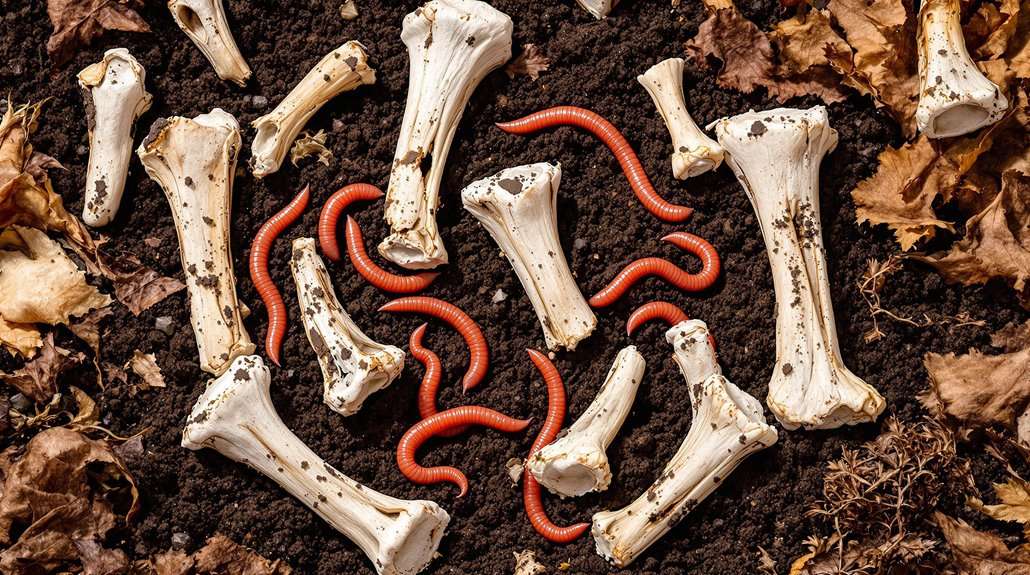
Before you can successfully compost bones, you'll need to understand their complex structure. Bones are far more than just hard, lifeless materials – they're sophisticated compositions of organic and inorganic elements that work together to create a remarkably strong yet lightweight structure.
When you're dealing with bones in composting, you're mainly working with two main components: the organic materials, which include type I collagen fibers and various proteins, and the inorganic mineral content, largely hydroxyapatite. The mineral portion makes up about 60-70% of the bone's dry mass, while water accounts for 10-20% in living bone tissue. This composition explains why bones are so challenging to break down in typical compost conditions. The triple helical structure of collagen provides exceptional strength to the bone material.
You'll find two distinct types of bone structure in your compost pile: cortical and cancellous bone. The dense, outer cortical bone comprises about 80% of adult bone mass and is particularly resistant to decomposition. The inner cancellous bone, with its honeycomb-like structure of trabeculae, makes up the remaining 20% and typically breaks down more readily due to its greater surface area and porosity.
Benefits Of Composting Bones
When you compost bones, you'll greatly enhance your soil quality through the natural release of essential minerals like calcium and phosphorus, which promote robust plant growth and improved soil structure. You're creating a sustainable alternative to commercial fertilizers while keeping valuable organic matter out of landfills, where it would otherwise contribute to greenhouse gas emissions. By incorporating bones into your compost, you'll establish a closed-loop system that transforms what might be considered waste into a nutrient-rich resource for your garden. The slow decomposition process of bones creates a long-term fertilizer effect, ensuring steady nutrient availability throughout multiple growing seasons.
Soil Quality Enhancement
Composting bones consistently improves soil quality by enriching it with essential nutrients like calcium and phosphorus. These minerals play an important role in promoting healthy root development and overall plant vitality, creating a sustainable source of nourishment for your garden that reduces the need for chemical fertilizers. Hot composting methods are particularly effective for breaking down bones efficiently.
When you add bone matter to your compost, you'll notice enhanced microbial activity as the bones release nitrogen during decomposition. This process creates an ideal environment for beneficial microorganisms that break down organic matter efficiently. You'll achieve the best results by maintaining proper moisture levels and ensuring regular aeration through turning your pile, which prevents anaerobic conditions and unwanted odors.
Breaking down bones into smaller pieces and layering them with nitrogen-rich materials markedly accelerates the decomposition process. As the bones decompose, they'll continuously release nutrients into your soil, supporting a balanced ecosystem that's essential for long-term soil health. This natural approach not only improves your garden's productivity but also contributes to sustainable practices by reducing waste and decreasing your reliance on synthetic fertilizers.
Natural Fertilizer Alternative
As an alternative to commercial fertilizers, bone-based compost offers remarkable benefits for sustainable gardening. You'll find that properly composted bones release essential nutrients gradually, providing your plants with a steady supply of phosphorus and calcium that's critical for healthy growth and development.
When you incorporate bone meal into your garden soil, you're creating a long-term investment in soil fertility. The fine particles from ground bones work as an effective soil enhancer, particularly supporting root development and flowering. Higher temperatures from increased microbial activity ensure thorough decomposition of organic matter. You're not just adding nutrients; you're improving the soil's structure and its ability to retain moisture and nutrients over time.
You can maximize these benefits by choosing different types of bones, from poultry to fish, each contributing unique nutrient profiles to your compost. Through proper preparation methods like boiling or grinding, you'll create a versatile fertilizer that's both cost-effective and environmentally friendly. The microbial activity in bone compost also helps maintain ideal soil temperatures, promoting rapid plant growth while enhancing overall soil health. This natural approach to fertilization supports sustainable gardening practices while reducing your dependence on synthetic fertilizers.
Reduced Landfill Waste
The landfill impact of bone waste has reached critical levels, but you can make a significant difference through composting. When you divert bones from landfills through composting, you're not just reducing waste volume – you're actively contributing to environmental sustainability and resource conservation. Your composted bones will decrease methane emissions while enriching soil with essential nutrients like calcium and phosphorus. Advanced microbial decomposition processes help break down organic bone material efficiently while maintaining optimal nutrient retention.
| Benefit Type | Environmental Impact | Economic Value |
|---|---|---|
| Waste Reduction | 30-40% less landfill volume | Lower disposal costs |
| Resource Conservation | Reduced synthetic fertilizer need | Savings on fertilizer purchases |
| Emissions Control | Decreased methane production | Carbon credit potential |
| Soil Health | Enhanced nutrient content | Improved crop yields |
| Water Quality | Reduced leachate contamination | Lower remediation costs |
You'll find that composting bones creates multiple advantages for waste management efficiency. By processing bones through composting instead of traditional disposal methods, you're helping to minimize toxic leachate that could contaminate groundwater. This practice also supports local agriculture by providing nutrient-rich soil amendments, while simultaneously meeting increasingly strict waste reduction regulations and environmental standards.
Preparing Bones For Decomposition
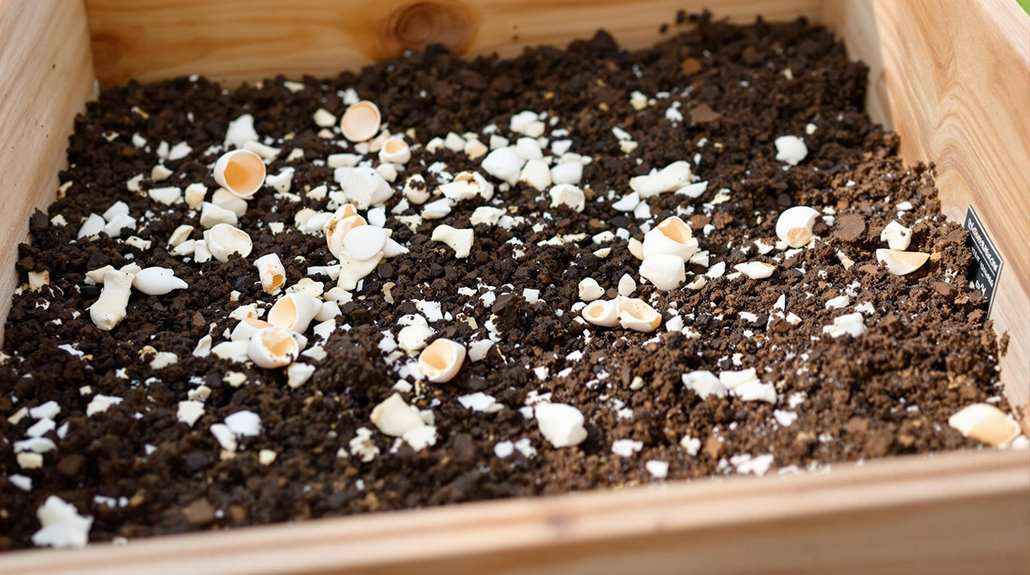
Before placing bones into your compost pile, proper preparation guarantees faster decomposition and better nutrient integration. You'll need to start by cleaning the bones thoroughly, either by boiling them to remove attached meat and fat or using a pressure cooker for more stubborn organic matter. Adding sugar-rich fruits alongside the bones can help support beneficial microbes. After cleaning, scrape off any remaining residue with a knife or brush, then rinse and dry them completely.
To accelerate decomposition, you'll want to break down the bones into smaller pieces. Using a hammer or grinder while wearing protective gear, crush the bones to increase their surface area for microbial activity. You can then soak these fragments in a water-vinegar solution to soften them further. For enhanced nutrient extraction, consider lightly charring the bones to remove any remaining grease.
The final step involves thoroughly drying the processed bones. You'll need to dehydrate them at 158-160 degrees Fahrenheit for about 10 hours, ensuring moisture content drops below 10%. Once dried, you can grind the bones into a powder, which will integrate more efficiently into your compost and release valuable phosphate calcium into the soil.
Best Methods For Bone Composting
Successfully composting bones requires choosing the right method for your specific needs and setup. You'll find that hot composting and Bokashi fermentation are the most effective approaches for breaking down bones at home, with each offering distinct advantages for different situations. Burning bones and mixing them with wood fuel materials can significantly speed up decomposition in your compost.
- Hot composting maintains temperatures between 90-140°F, requiring you to layer crushed bones at the center of your pile
- Bokashi composting uses fermentation in an anaerobic environment, making it ideal for small spaces
- Bone meal production offers a practical alternative when immediate composting isn't feasible
For hot composting, you'll need to maintain a precise 25:1 to 30:1 ratio of brown to green materials while keeping moisture levels balanced. If you're using the Bokashi method, you'll want to soften the bones first by boiling them and add extra Bokashi bran to guarantee proper fermentation. When space or time is limited, you can create bone meal by boiling, drying, and grinding the bones into a fine powder. This versatile product can be mixed directly into your garden soil or combined with compost tea for enhanced nutrient delivery to your plants.
Safety Precautions When Handling Bones
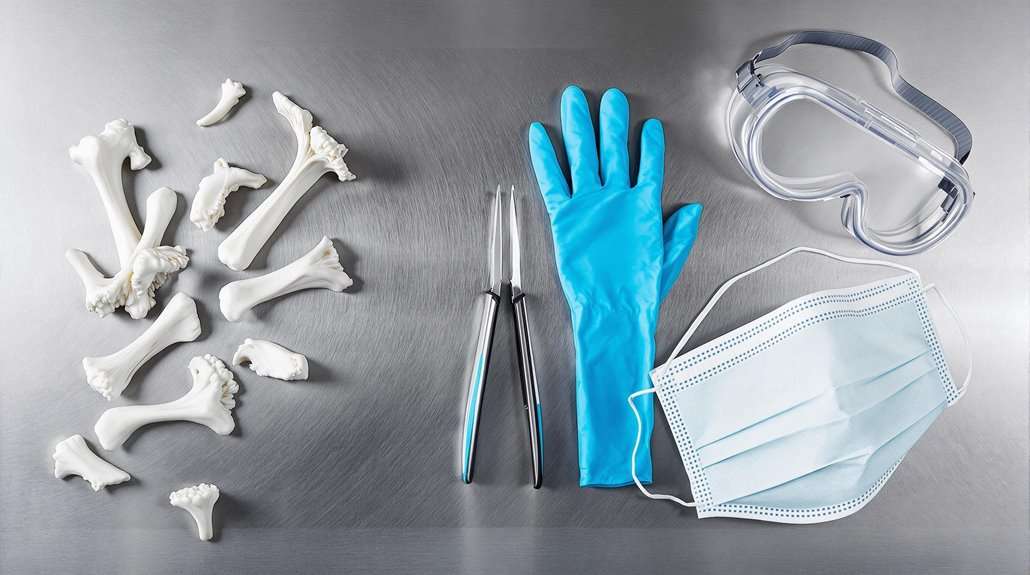
Safe handling of bones during composting requires strict protective measures to prevent injury and contamination. You'll need to wear protective gear, including gloves and safety goggles, especially when breaking bones into smaller pieces. Before adding bones to your compost, you must remove all meat and fat to prevent attracting unwanted pests. Since bones are among the materials to avoid in home composting, proper precautions are essential.
| Safety Measure | Purpose |
|---|---|
| Boil bones for 1 hour | Loosens remaining meat and tissue |
| Use rodent-proof bins | Prevents pest infestations |
| Bury bones deeply | Reduces animal attraction |
| Regular pile turning | Maintains proper aeration |
| Wear protective gear | Prevents injury and contamination |
When preparing bones for composting, you'll want to clean them thoroughly by boiling, scraping, and rinsing. After cleaning, break the bones into smaller pieces to speed up decomposition, but always use appropriate tools and protective equipment during this process. You should maintain a clean working area and regularly inspect your compost pile for signs of pest activity or improper decomposition. If you're concerned about achieving proper decomposition temperatures, consider using a commercial composting facility, as they're better equipped to handle materials that require high temperatures for safe breakdown.
Common Challenges With Bone Composting
Composting bones presents several notable challenges that you'll need to overcome for successful decomposition. One of the biggest issues you'll face is the extended time required for bones to break down completely, which can range from several months to multiple years, especially if you're working with whole, uncut bones. You'll also need to manage odors carefully, as decomposing bones can produce strong, unpleasant smells that attract unwanted visitors to your compost pile. Using an enclosed composter system can help bones break down within 3-4 weeks when conditions are optimal.
Here are the main challenges you'll encounter when composting bones:
- Pest attraction: Raw bones can attract rodents, raccoons, and other wildlife, potentially spreading disease and disrupting your compost pile
- Slow decomposition rates: Dense bone material resists breakdown, particularly in cold composting systems
- Limited composting methods: Not all composting techniques work well with bones – traditional bins and vermicomposting aren't suitable for whole bones
Your choice of composting method considerably impacts success rates. While cold composting isn't effective for bones, hot composting can work if you maintain proper temperatures and turning schedules. You'll need to reflect on using specialized methods like Bokashi composting or grinding bones into meal for faster decomposition.
Time Required For Bone Decomposition
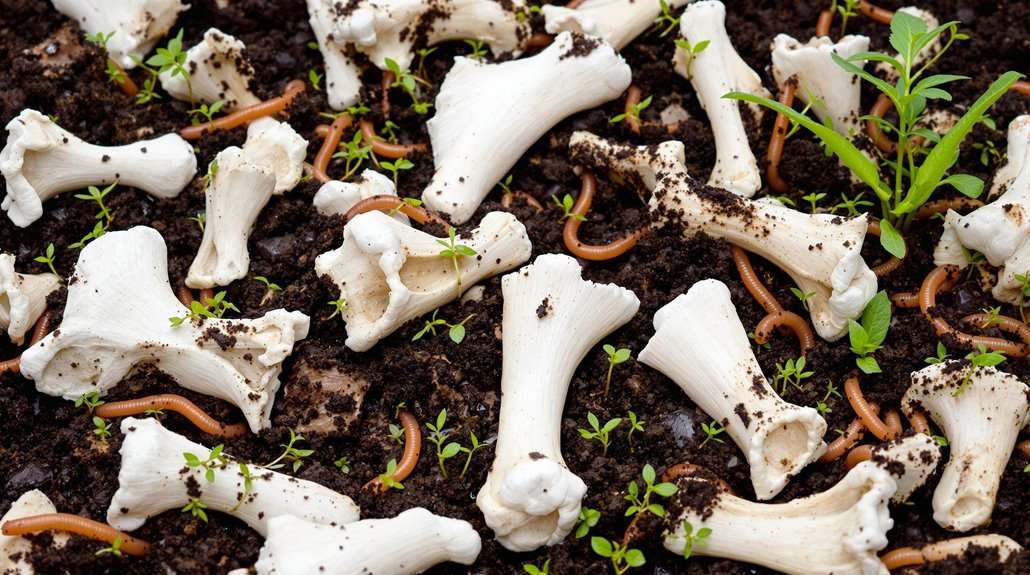
You'll find that different types of bones break down at remarkably different rates, with small bones taking several months while large bones can require five years or more to fully decompose. The speed of decomposition depends heavily on factors like temperature, moisture levels, and how well you've prepared the bones through grinding or crushing. If you're looking to speed up the natural breakdown process, maintaining temperatures between 130-160°F and regularly turning your compost pile will greatly accelerate decomposition rates. Backyard compost piles typically don't reach the high temperatures needed for optimal bone decomposition.
Decomposition Speed By Type
Bone decomposition times vary considerably based on size and type, ranging from a few months to several years in a compost pile. You'll find that small bones, like those from fish and poultry, decompose relatively quickly – typically within two to three months when properly prepared and maintained in your compost.
Medium-sized bones require more patience, taking one to three years to break down completely. When you're working with larger bones, such as those from large animals, you're looking at a timeline of five years or more, especially if they haven't been pulverized or mechanically reduced. Hydrolysis processes play a crucial role in breaking down the organic components of bones.
- Small fish bones decompose fastest, breaking down in just a few months when maintained in a hot compost pile
- Medium-sized bones break down more efficiently when mixed with nitrogen-rich materials and kept at 130-160°F
- Large, dense bones may need mechanical reduction and can take up to a decade to fully decompose
To speed up the process, you'll want to maintain proper composting conditions, including adequate heat, moisture, and aeration. Breaking or crushing the bones before adding them to your pile will greatly accelerate their decomposition by increasing the surface area exposed to beneficial microorganisms.
Accelerating Natural Bone Breakdown
Several proven methods can dramatically speed up the natural decomposition of bones in your compost pile. Start by boiling the bones for 30-60 minutes to soften their structure and eliminate harmful bacteria. Once cooled, you'll want to break them down into smaller pieces using a meat grinder or mortar and pestle, as increased surface area accelerates decomposition greatly. An electric composter like Lomi can process small cooked bones in under 24 hours.
For best results, maintain your compost pile's temperature between 130-160 degrees Fahrenheit, which creates ideal conditions for microbial activity. You can achieve this by regularly aerating the pile and mixing the ground bones with brown materials like straw and dead plants. Consider using a bokashi composter, which ferments the bones and removes pathogens while speeding up the breakdown process.
When adding bones to your pile, bury them deeply to minimize pest attraction and maximize decomposition efficiency. While thick, unprocessed bones might take years to break down naturally, these acceleration techniques can reduce decomposition time greatly. Remember to control moisture levels by avoiding wet bones, as excess moisture can lead to anaerobic conditions and unpleasant odors in your compost pile.
Essential Tools And Materials
Successful bone composting requires a thorough set of tools and materials to process and break down the dense organic matter effectively. You'll need preprocessing equipment like a large boiling pot, scraping tools, and a heavy-duty grinder to prepare the bones for decomposition. For safety during grinding and processing, don't forget to wear protective goggles and gloves.
- A thermometer to monitor internal compost temperatures, ensuring ideal microbial activity
- Bokashi components, including specialized bran and fermenting equipment, for accelerated breakdown
- Nitrogen-rich materials to balance the carbon-heavy bones in your mix
Your composting setup should include both primary and secondary processing tools. A dedicated compost bin provides the foundation, while aeration tools help maintain proper oxygen levels. You'll find that additional materials like vinegar solutions and pressure cooking equipment can greatly speed up the decomposition process. When working with larger bones, consider using a combination of methods: start with boiling and grinding, then shift to fermentation with bokashi microbes. Keep your screening equipment handy to filter out any non-organic materials that might contaminate your final compost product.
Environmental Impact Of Bone Composting
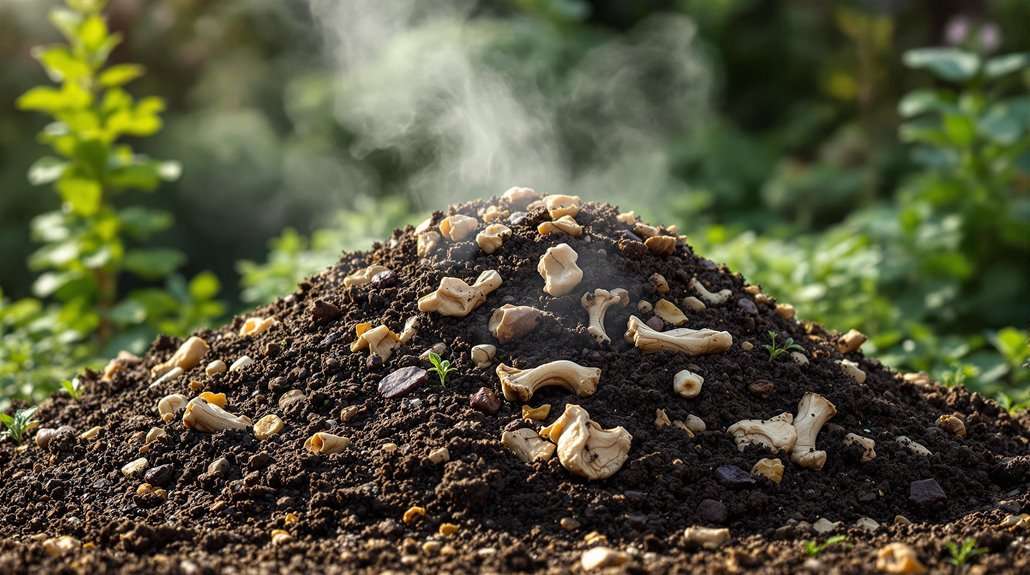
When it comes to the environmental footprint of bone composting, you'll find both significant benefits and potential drawbacks to assess. On the positive side, bones contribute essential minerals to your soil, particularly calcium and phosphorus, which help prevent acidification and promote robust plant growth. You'll notice that bone meal serves as an excellent soil enhancer, especially for root development in your garden. Recent studies show that prolonged composting periods may be necessary to achieve complete bone degradation.
However, you'll need to reflect on several environmental challenges when composting bones. Without proper management, you're likely to encounter pest problems, as the decomposing bones can attract unwanted visitors like raccoons, dogs, and rodents. Additionally, if you're not careful with moisture levels, wet bones can create anaerobic conditions, leading to unpleasant odors in your composting area. While dense bones can remain in your compost for extended periods, causing uneven decomposition, you can mitigate this issue by pulverizing them before adding them to your pile. For ideal environmental impact, you'll want to maintain proper composting conditions, including appropriate carbon-to-nitrogen ratios and regular pile rotation, to guarantee thorough decomposition and maximize soil benefits.
Frequently Asked Questions
Can Cooked Fish Bones Be Composted Faster Than Chicken Bones?
Like a prehistoric comparison, you'll find that fish bones do compost faster than chicken bones due to their smaller size and lower density. When you're managing your compost pile, you'll notice fish bones breaking down in several months to a year, while chicken bones typically take 5-10 years. You'll get better results if you crush both types first and maintain proper temperature and moisture levels.
Will Composted Bones Affect the Ph Balance of My Garden Soil?
Yes, composted bones will affect your soil's pH balance, primarily due to their high calcium content. You'll find they're particularly effective in slightly acidic soils, where they can help neutralize acidity. When you add bone meal to your garden, it'll gradually release calcium and phosphorus, helping to stabilize pH levels over time. However, you won't see significant pH changes if your soil is already alkaline.
Are Eggshells More Effective Than Bones for Adding Calcium to Compost?
While you might think bones are the heavyweight champion of calcium supplementation, eggshells actually win this round. You'll get faster calcium release from eggshells, and they're easier to break down in your compost. They don't attract pests or create odors like bones can. Plus, you'll save time since eggshells only need crushing, while bones require boiling and grinding for effective decomposition.
Can I Compost Bones From Store-Bought Rotisserie Chickens and Prepared Meals?
Yes, you can compost bones from rotisserie chickens and prepared meals, but you'll need to follow specific guidelines. Break down the bones into smaller pieces to speed up decomposition, and always bury them deep in your compost pile under brown materials like leaves or paper. Be aware that chicken bones typically take 5-10 years to fully decompose in backyard settings, and you'll need to maintain proper temperature and turning schedules.
Should I Separate Different Types of Bones When Composting Them?
Like sorting your laundry prevents color bleeding, separating bones when composting helps optimize decomposition. You'll want to keep larger bones, like beef or pork, separate from smaller ones like chicken or fish bones. Small bones can break down in a standard compost pile, while you'll need to crush or grind larger bones first. This separation guarantees faster decomposition and helps maintain proper temperature levels throughout your compost.





